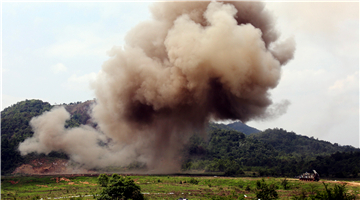
A resident plays with her children on a square in the new Beichuan county earlier this month. ZOU HONG/CHINA DAILY
The new Beichuan county project went quickly, starting on May 25, 2009 with support from Shandong province. It was completed in only 15 months, on Sept 25, 2010.
"We're proud of the speed and scale of our reconstruction, which is an extraordinary achievement by any standard and should make China proud," Zhang said. "Only a big, strong country with a powerful government can achieve this."
Wang Shoulei, director of Beichuan county's publicity department, said the newly restored area is a hot tourism attraction for visitors, both to see the new lives of earthquake survivors and the region's unique ethnic culture.
In China's only Qiang autonomous county-a sort of living museum -tourists can enjoy the signature commercial pedestrian street, which was built with Qiang architectural features. Customs are also preserved and celebrated.
The Banaqia district, the landmark project of the new county, is now a busy shopping street consisting of cafes, restaurants and shops with local specialties and Qiang ethnic crafts demonstrated by locals. "Banaqia" means market in the Qiang language.
Large-scale shows are staged in the public area, including a dragon dance and Qiang ethnic songs and other performances. Visitors can joined locals for a Qiang-style campfire and outdoor dinner, and take home some of Beichuan's famous smoked food, including pork, sausage and wild animal meat.
In 2017, the number of domestic tourists reached 6.35 million, with total tourism revenue of 5.1 billion yuan, 13.5 times the money generated in 2007, according to the county government.
But a complete community cannot be created just by building houses and businesses. The reconstruction of lives is a more arduous task.
"I was born and grew up in the old county. It's not easy to say goodbye to a place so familiar," said An Ping, 47, a Beichuan resident who lost her 11-year-old daughter in the quake.
"But I support rebuilding in another place. It would only break people's hearts to remain, with so many beloved ones sleeping beneath you."
She remarried after the quake and now has 7-year-old twin daughters. They lived in makeshift houses for two years before moving into their new home in early 2011.
"I could barely survive before the birth of my twin girls. They gave me hope to live on," An said.
On the bedhead of the girls' room there is a photograph of An's first daughter, whose body was never found. The twins call her their "big sister".
An also received comfort from many other families that shared similar experiences. More than 10,000 people from the old county seat who survived the quake have been relocated in two adjacent neighborhoods. Although they didn't know each other so well before, they now have an intimate and powerful bond born of grief and trauma.











